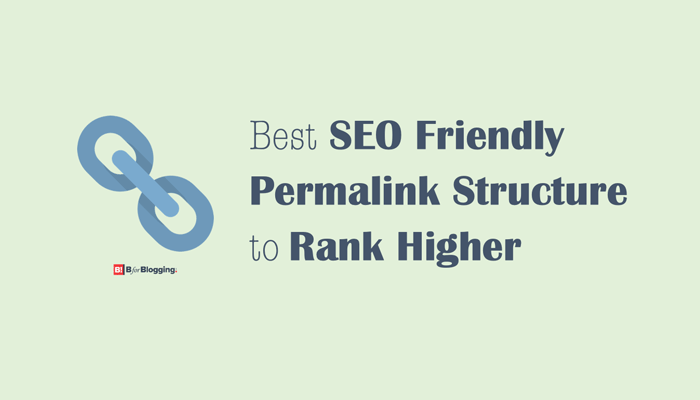Learn What is SEO Friendly URL Structure? Identify the Best WordPress Permalink Structure for SEO and also Learn How to Change the Perfect WordPress SEO Permalink Structure to level up your SEO game and Rank Higher in Search Results.
Starting with a blog or website is a fun part and one of the most important aspects while you start your blog or website is Search Engine Optimization.
You must have heard that there are more than 200 factors to get a higher ranking in Search Engine Results. And the SEO Friendly URL Structure is one of the most important factors to get higher rankings.
What is SEO Friendly URL (Permalink Structure)?
URL describes a blog or website to its visitor and search engines. Making your blog URLs significant, convincing and perfect is the key to rank well in search engine results.
When a search engine crawls your blog or website, crawler (spiders) first analyze the URL of a blog post. If it finds URLs a little bit confusing, it may end up indexing the website and may chance to lose search engine ranking.
So, keeping URLs well-structured and relevant to the topics can increase the chance to attract more visitors from search engine results.
See below image by moz.com about SEO Cheat Sheet about the Anatomy of a URL [1] for more details.

What is Search Engine Friendly Permalink in WordPress?
In WordPress, permalinks word is defined as permanent links of the web address to link the content of a page, a post, a category, and tag archives.
This means the URLs of each content should be permanent and never change. Thus, it names as permalinks.
Apart from the default permalinks structure, all of the permalink structures in WordPress are search engine friendly, which includes %post_id% in the URLs.
This structure of permalinks referred to as a “Pretty Permalinks” or “Clean URLs”. Read more about it here. Learn what Yoast has to say about permalink structures here.
How to Edit Permalinks in WordPress
You can edit WordPress permalinks by visiting Settings → Permalinks in the admin area.
On this page, you’ll find various types of permalinks structure in WordPress like Plain, Day and name, Month and name, Numeric, Post name, and Custom Structure.
Further, I am going to explain all the permalinks structure types in detail.

Plain – https://saurabhk.com/?p=123
This option is WordPress’s default URL structure which is a non-SEO friendly URL structure, and it looks like the above-mentioned URL.
Day and name – https://saurabhk.com/2016/06/22/sample-post/
This permalink structure option is fairly SEO-friendly because it contains post name in the URL structure. But this URL structure is a bit of lengthy because it also includes date format.
This kind of permalink structure is not right for the blog because it contains date format. And for that reason, your post or content may seem outdated, even if you regularly update it.
Month and name – https://saurabhk.com/2016/06/sample-post/
This option contains a month and post name in the URL structure, so it is a bit similar to the day and name. Permalink structure with the month and post name is SEO friendly for a news-related website.
Numeric – https://saurabhk.com/archives/123
The numeric option of permalink structure in WordPress contains the number only no post name, so this option is non-SEO friendly.
Post name – https://saurabhk.com/sample-post/
Post name is the most SEO friendly permalink structure for WordPress because it is short and contains post name only. It is the default URL structure in the latest WordPress.
Custom Structure, this kind of URL structure is used to a great for a publication site, because of the flexibility to customize an SEO friendly permalink structure as per your requirements using the available tags.
Let us learn how to create the custom URL structure in WordPress.
How to change the perfect WordPress SEO Permalink Structure using the custom structure option.
As you already know that with the combination of several tags, you can create a custom URL structure in WordPress.
Below, I have listed all the available tags that you can use to create your custom URL structure in WordPress.
- %year% – This tag helps to show the year of the post in four digits like 2020.
- %monthnum% – This tag indicates the month of the year in number like 05.
- %day% – This tag indicates the day of the month like 22.
- %hour% – This tag indicates the hour of the day like 11.
- %minute% – This tag indicates a minute of the hour like 30.
- %second% – This tag indicates the second of the minute like 15.
- %postname% – This tag helps to indicate the post name in the URL structure. For example, if the post name is what is WordPress than in URL structure it will show like what-is-WordPress.
- %post_id% – This tag helps to create a unique ID of the post like 124.
- %category% – This tag shows the category name in the URL structure.
- %author% – This tag shows the author’s name in the URL structure.
How to Change the Permalinks in WordPress
- Log in to your WordPress dashboard.
- Head over to Settings → Permalinks using the dashboard menu.
- Choose the best permalink structure for SEO using the Common Settings option on the Permalink Settings page.
- Click on the Save Changes button and you are done.
Once you save the changes after choosing your required Permalink structure, WordPress will automatically update your site’s .htaccess file, and you’ll see the changes in your site’s URL structure.
Things to Keep in Mind before Changing Permalink Structure
There are certain notes that you need to take care of, and those are listed below:
- It will not be sufficient to change the Permalink Structure of your WordPress site if it has run for more than 6 months.
- There is a risk of changing your permalinks structure on an established site because you can lose your entire social media share and yes, of course, the existing SEO ranking too. Even after expert advice, you can lose social share.
- If your site URL is plain then no matter how old your site is, you can still change your permalink structure. Yes, but you still lose your social share counts.
Must Read: How To Safely Change Permalink Structure In WordPress Without Killing Rankings: Definitive Guide
Top 10 Tips for the Best SEO Friendly permalink structure for your Blog
Here are the top 10 tips for the best permalink structure for SEO:
- Use HTTPS with the Permalink of your Blog.
- Do not use ‘www’ in your Permalinks.
- Use the ‘Post Name’ option in the WordPress Permalink Settings.
- You should use Hyphens ( – ) in the Permalink instead of underscores ( _ ).
- Only use Dates in your Permalink if you are a News Publication.
- Use ‘Categories’ with your e-commerce site’s Permalinks.
- Don’t let WordPress create your slug for your posts.
- Try to keep your Permalinks short.
- Make sure to use your Focused Keywords (FKW) in your post Permalinks.
- Remove Stop Words from your Permalinks i.e. is, them, to, for, etc.
If you want to take your SEO game at the next level, start following these tips for the best permalink structure. You will definitely see positive growth in your search engine ranking.
Further, I am going to answer a couple of common questions related to the best permalink structure.
Q. What is the best permalink structure for SEO?
A. The best permalink structure for SEO is the domain name + post name i.e. https://saurabhk.com/sample-post/
Q. What is the best permalink structure for WooCommerce?
A. SEO friendly URL for WooCommerce or the best permalink structure for your shopping website is the domain name + main-category + sub-category + product name i.e. https://saurabhk.com/%category%/%product_cat%/%product_name%/
Q. What are the best WordPress custom permalinks?
A. The best WordPress custom permalink is the domain name along with the post name tag i.e. https://saurabhk.com/%postname%/
Q. How to add www to my website?
A. To add www to your website, head over to the Settings → General using the WP dashboard menu. On the General Settings page, add the www in the WordPress Address (URL) and Site Address (URL) options.
I hope you like the article on the Best Permalink Structure SEO Friendly URL for WordPress.
If you like the article, do share it across social media channels with your friends and keep spreading the good word!
Any question?
Ask here, and I will get back to it very soon.
Stay tuned for more of such updates on Facebook and Twitter.
More to read –




